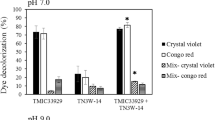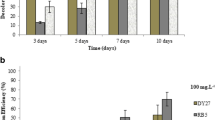Abstract
Aspergillus sojae B-10 was immobilized and used to treat model dye compounds. The model wastewater, containing 10 ppm of azo dyes such as Amaranth, Sudan III, and Congo Red, was treated with cells attached to a rotating disc contactor (RDC). Amaranth was decolorized more easily than were Sudan III and Congo Red. Decolorization of Amaranth began within a day, and the dye was completely decolorized within 5 days of incubation. Both Sudan III and Congo Red were almost completely decolorized after 5 days of incubation. Semicontinuous decolorization of azo by reusing attached mycelia resulted in almost complete decolorization in 20 days. This experiment indicated that decolorization was successfully conducted by removing azo dyes withAspergillus sojae B-10.
Similar content being viewed by others
References
Easton, J. R. (1995) The dye marker’s view. pp. 19–27 In: Cooper P. (Ed.) Colour in Dyehouse Effluent.
Meyer, U. (1981) Biodegradation of synthetic organic colorants.FEMS/SYMP. 12, 31–385.
Lee, H. Y., S. H. Choi, and M. B. Gu (2003) Response of bioluminescent bacteria to xixteen azo dyes.Biotechnol. Bioprocess Eng. 8: 101–105.
Leisinger, T. and W. Brunner (1986) Poorly degradable substance, P. 497–498. In: H. S. Rehmand and G. Reed (ed), Biotechnology, a comprehensive treaties in eight volumes,Microbial degradation, VCH, Verlagsgessellschaft, Germany.
Anlider, R. (1979) Ecotoxicology of dyestaffs joint effort by industry.Ecotoxicol. Environ. Suf. 3: 59–74.
Nigam, P., I. M. Banat, D. Singh, and R. Merchant (1996) Microbial process for the decolourization of textile effluent containing azo, diazo and reactive dyes.Process Biochem. 31: 435–442.
Zissi, U. and G. Lyberatos (1996) Azo-dye biodegradation under anoxic conditions.Wat. Sci. Technol. 34: 495–500.
O’Neill, C., A. Lopez, S. Esteves, D. L. Hawkes, and S. Wilcox (2000) Azo-dye degradation in an anaerobicaerobic treatment system operating on simulated textile effluent.Appl. Microbiol. Biotechnol. 53: 249–254.
Johnson, R. F., A. Zenhausern, and H. Zollinger (1978) Azo dyes, pp. 868–910. In: H. F. Mark, J. J. Makita, Jr., D. F. Othmer and A. Standen (eds.). Kirk-Othmerencyclopedia of chemical technology, 2nd ed., vol. 2, John Wiley & Sons, Inc., New York, USA.
Haugh, W., A. Schmidt, B. Nortman, D. C. Hempel, A. Stolz, and H. J. Knackmuss (1991) Mineralization of the sulfonated azo dye mordant yellow 3 by a 6-aminonaphthalene-2-sulfonate degrading bacterial consortium.Appl. Environ. Microbiol. 57: 3144–3149.
Weber, E. J. (1991) Studies of benzidine-based dyes in sediment-water systems.Environ. Toxicol. Chem. 9: 609–617.
Brown, D., H. R. Hits, and L. Schafer (1981) The assessment of the possible inhibitory effect of dye-stuffs on aerobic wastewater bacteria: experience with a screening test.Chemosphere. 10: 215–261.
Chang, H. M. (1987) Process of treating effluent from a pulp or papermaking operation.US Patent 4,655,926.
Glenn, J. K. and M. H. Gold (1983) Decolorization of several polymeric dyes by the lignin-degrading Basidiomycete.Phanerochaete chrysosporium.Appl. Environ. Microbiol. 45: 1741–1747.
Platt, M. W., Y. Hadar, and H. Chet (1985) The decolorization of the polymeric dye poly-blue(polyrinalamine sulfonate anthroquinone) by lignin degrading fungi.Appl. Microbiol. Biotechnol. 21: 396–406.
Michaels, G. B. and D. L. Lewis (1986) Microbial transformation rates of azo triphenylmethane dyes.Environ. Toxicol. Chem. 5: 161–166.
Ryu, W. Y., M. Y. Jang, and M. H. Cho (2003) The selective visualization of lignin peroxidase, manganese peroxidase and laccase, produced by white rot fungi on solid media.Biotechnol. Bioprocess Eng. 8: 130–134.
Zimmerman, T., H. G. Kulla, and T. Leisiger (1982) Properties of purified orange azoreductase, the enzyme initiating azo dye degradation byPseudomonas KF 46.Eur. J. Biochem. 129: 197–203.
Wuhrmann, K., K. L. Mechsner, and T. H. Kappeler (1980) Investigation on rate-determining factors in the microbial reduction of azo dyes.Eur. J. Appl. Microbiol. Biotechnol. 9: 325–338.
Yatome, C., T. Ogawa, D. Koda, and E. Ikeda (1981) Biodegradability of azo and triphenylmethane dyes byPseudomonas pseudomallei 13NA.J. Soc. Fiber Sci. Technol. Japan 97: 166–169
Brown, D., H. R., Hits, and L. Schafer (1981) The assessment of the possible inhibitory effect of dye-stuffs on aerobic wastewater bacteria: Experience with a screening test.Chemosphere 10: 215–261.
Iggleden, G. J. (1981) Rotating biological contactors,Chemistry and Industry 13, 4. July 458–465.
Olem, H. and R. F. Unz (1980) Rotating disc biological treatment of acid mine drainage.J. Water Pollution Control-Federation 52: 257–269.
Ryu, B. H. and Y. D. Won (1992) Decolorization of azo dyes byAspergillus sojae B-10.J. Microbiol. Biochem. 2: 215–219.
Bumpus, J. A. and B. J. Brock (1988) Biodegradation of crystal violet by the white rot fungusphanerochaecte chrysosporium.Appl. Environ. Microbiol. 54: 1143–1150.
Author information
Authors and Affiliations
Corresponding author
Rights and permissions
About this article
Cite this article
Ryu, B.H. Semicontinuous decolorization of azo dyes by rotating disc contactor immobilized withAspergillus sojae B-10. Biotechnol. Bioprocess Eng. 9, 309–312 (2004). https://doi.org/10.1007/BF02942349
Received:
Accepted:
Issue Date:
DOI: https://doi.org/10.1007/BF02942349




